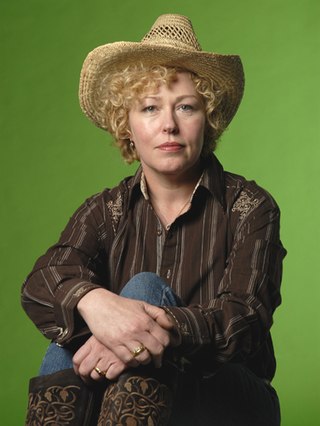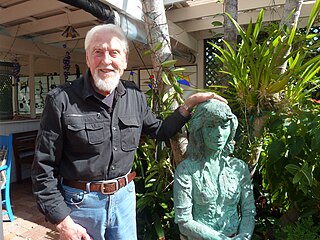Related Research Articles
Elizabeth Ann Dewar Churcher was an Australian arts administrator, best known as director of the National Gallery of Australia from 1990 to 1997. She was also a painter in her own right earlier in her life.
Rover Thomas Joolama, commonly known as simply Rover Thomas, was a Wangkajunga and Kukatja Aboriginal Australian artist.
Davida Frances Allen is an Australian painter, filmmaker and writer.
Gordon Bennett was an Australian artist of Aboriginal and Anglo-Celtic descent. Born in Monto, Queensland, Bennett was a significant figure in contemporary Indigenous Australian art.
Vivienne Joyce Binns is an Australian artist known for her contribution to the Women's Art Movement in Australia, her engagement with feminism in her artwork, and her active advocacy within community arts. She works predominantly in painting.
Australian feminist art timeline lists exhibitions, artists, artworks and milestones that have contributed to discussion and development of feminist art in Australia. The timeline focuses on the impact of feminism on Australian contemporary art. It was initiated by Daine Singer for The View From Here: 19 Perspectives on Feminism, an exhibition and publishing project held at West Space as part of the 2010 Next Wave Festival.
Diane Mantzaris is an Australian artist known for her pioneering application of digital imaging to printmaking and for her unconventional approach to image making, which is often both personal and political in content. Mantzaris pioneered the use of computers as a printmaking and art-making tool in the early to mid-1980s, exhibiting widely, nationally and throughout Asia in touring exhibitions, to considerable acclaim. Her practice now crosses into several fields associated with the visual arts, printmaking, drawing, photography, sculpture, performance and public art. She is represented in most state and public collections throughout Australia and significant private collections throughout Asia and Europe.
Alun Leach-Jones, was a British-born Australian artist known for his range of work covering painting, drawing, sculpture, linocuts, screenprints and etchings.

Udo Sellbach (1927–2006) was a German-Australian visual artist and educator whose work focused primarily around his printmaking practice.

Bernard Ollis OAM is a British-Australian artist, painter and advocate for arts education. He lives and works in Sydney and Paris.

Linde Ivimey is an Australian sculptor.
Ann Foster Newmarch, known as "Annie", was a South Australian painter, printmaker, sculptor and academic, with an international reputation, known for her community service to art, social activism and feminism. She co-founded the Progressive Art Movement and the Women's Art Movement (WAM) in Adelaide, and is especially known for her iconic 1978 colour screenprint piece titled Women Hold Up Half the Sky!.
Aida Tomescu is an Australian contemporary artist who is known for her abstract paintings, collages, drawings and prints. Tomescu is a winner of the Dobell Prize for Drawing, the Wynne Prize for Landscape and the Sir John Sulman Prize, by the Art Gallery of New South Wales.
Andrew John Sibley was an English-born Australian artist. Sibley has been the subject of three books and is commonly listed in histories and encyclopedias of Australian art as a significant figurative painter of the mid and late 20th century.
The australian Girls Own Gallery (aGOG) was a commercial art gallery that operated in Leichhardt Street, Kingston in Canberra from 1989 to 1998. The gallery was owned and operated by former National Gallery of Australia curator Helen Maxwell, and exhibited the work of women artists almost exclusively.

Marc Clark was a British-born Australian academic, sculptor and printmaker.
Carol McGregor is an Indigenous Australian artist of Wathaurung (Victoria) and Scottish descent, internationally known for her multi media installation pieces bringing together ephemeral natural fibres, metal, and paper. She is also deeply engaged in the creation of and cultural reconnection to possum skin cloaks, a traditional form of dress and important biographical cultural item.
Normana Wight is an Australian artist, best known as a painter and printmaker.
Mandy Martin was a contemporary Australian painter, printmaker and teacher. She was involved in the development of feminist art in Australia from the mid-1970s and as exhibited widely in Australia and internationally. In recent years she used the art she created as part of the ongoing debate on climate change, an area in which she was "prolifically active". Based in Canberra for many years, she was also a lecturer at the Australian National University (ANU) School of Art from 1978 to 2003. As well as being a visual artist, Martin was an adjunct professor at the Fenner School of Environment and Society at the ANU College of Medicine, Biology and Environment.

Alexander "Sasha" Dmitrievich Grishin is an Australian art historian, art critic and curator based in Victoria and Canberra. He is known as an art critic, and for establishing the academic discipline of art history at the Australian National University (ANU).
References
- ↑ "M.O.C.A. – Museum of Contemporary Art – feat. Young Artists Gallery". ARI Remix. 25 September 2021. Retrieved 11 March 2022.
- 1 2 3 4 5 Grishin, Sasha (29 August 1987). "Another challenge from Queensland". The Canberra Times . Vol. 61, no. 18, 957. p. 2. Retrieved 11 March 2022– via National Library of Australia.
- 1 2 "Vivienne Binns Curriculum Vitae" (PDF). Sutton Gallery. 2018. Retrieved 11 March 2022.
- ↑ "Paul Boston Bio". The Hughes Gallery. Archived from the original on 11 January 2014.
{{cite web}}: CS1 maint: unfit URL (link) - ↑ Museum of Contemporary Art (Brisbane, Qld.) (1987), Minimal art in Australia : a contemplative art : 5th September-21st October, 1987, Museum of Contemporary Art, ISBN 978-1-86267-001-3
- ↑ "What's on". Tribune . No. 2522. New South Wales, Australia. 6 July 1988. p. 10. Retrieved 11 March 2022– via National Library of Australia.
- ↑ "Trove". Trove. Retrieved 11 March 2022.
- ↑ Museum of Contemporary Art (Brisbane, Qld.) (1987), M.O.C.A. bulletin, Museum of Contemporary Art, ISSN 0819-9000